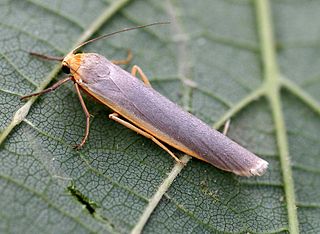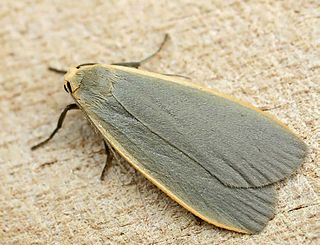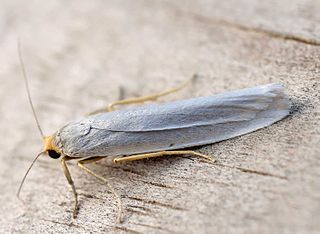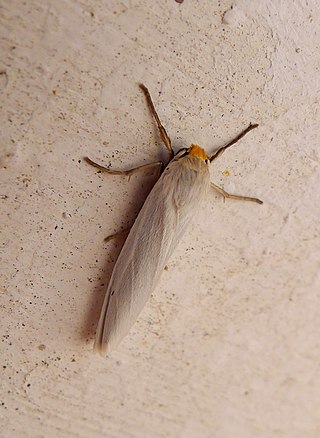
The common footman is a moth of the family Erebidae. The species was first described by Johann Leopold Theodor Friedrich Zincken in 1817. It is distributed throughout Europe and east through the Palearctic to Lake Baikal.
Capissa is a monotypic tiger moth genus in the family Erebidae. It was previously treated as a synonym of Eilema. Its only species, Capissa vagesa, is found in the north-western Himalayas, Kashmir, Nepal and Upper Myanmar. Both the genus and species were first described by Frederic Moore; the genus in 1878 and the species in 1860.

Eilema is a genus of moths in the subfamily Arctiinae. The genus was erected by Jacob Hübner in 1819.

Manulea complana, the scarce footman, is a moth of the family Erebidae. The species was first described by Carl Linnaeus in his 1758 10th edition of Systema Naturae. It is found throughout the Palearctic region.

Collita griseola, the dingy footman, is a moth of the family Erebidae. The species was first described by Jacob Hübner in 1803. It is found in Europe and North and South-East Asia.

Wittia sororcula, the orange footman, is a moth of the family Erebidae. The species was first described by Johann Siegfried Hufnagel in 1766. It is found in Europe, Anatolia and further east across the Palearctic to southern Siberia and the Amur basin to China.

Eilema uniola is a moth of the subfamily Arctiinae first described by Jules Pierre Rambur in 1866. It is found in Spain, Portugal, France and Italy.

Eilema caniola, the hoary footman, is a moth of the family Erebidae. The species was first described by Jacob Hübner in 1808.

Manulea palliatella is a moth of the family Erebidae. It is found in southern, central and eastern Europe, Asia Minor, Iran, Afghanistan, Central Asia, Kazakhstan.

Eilema lutarella is a species of moth in the family Erebidae. It is found in North Africa through Central Europe up to the area surrounding the Amur River and Sakhalin. In the north, it is found up to Scandinavia, Komi Republic in European Russia, Vitim river in Siberia.
Manulea pseudocomplana is a moth of the family Erebidae. It is found from central and southern Europe to Ukraine, Turkey and Iran.

Manulea (Setema) cereola is a moth of the family Erebidae. It is found in Fennoscandia, the Baltic States, European Russia as well as the Alps and Urals. The species was first described by Jacob Hübner in 1803.
Dolgoma cribrata is a moth of the family Erebidae first described by Otto Staudinger in 1887. It is found in eastern Asia, more specifically Russia, China, Korea and Japan.
Eilema albidula is a moth of the subfamily Arctiinae first described by Francis Walker in 1864. It is found in the Democratic Republic of the Congo, Nigeria and Sierra Leone.
Eilema angustipennis is a moth of the subfamily Arctiinae first described by Embrik Strand in 1912. It is found in Cameroon, Ghana and Uganda.
Eilema kingdoni is a moth of the subfamily Arctiinae first described by Arthur Gardiner Butler in 1877. It is found on Mayotte and Madagascar.
Eilema virgineola is a moth of the subfamily Arctiinae. It is found in South Africa.
Eilema plana, the little white lichen moth, is a moth of the subfamily Arctiinae. The species was first described by Jean Baptiste Boisduval in 1832. It is found in the Australian states of Queensland, New South Wales and Victoria.

Eilema costipuncta is a moth of the subfamily Arctiinae first described by John Henry Leech in 1890. It is found in China and Taiwan.











